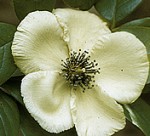 Silky stewartia is a multi-stemmed shrub or small tree native to the southeastern coast from Virginia to Florida and west to Louisiana where it grows in woodlands, woodland edges, and stream banks. It belongs to the tea family, Theaceae, that also includes camellias and franklinias. Horizontal branches carry light to dark green leaves that turn buttery yellow to orange and red in the fall. The oval to elliptical leaves have sharp pointed tips and finely toothed margins, and their undersides are covered with fine hair. In summer buds covered by two floral bracts with silvery hairs open to solitary, white, five-petaled flowers about three inches across with a center of forty to fifty purple stamens. The light gray bark is lightly flecked and especially attractive in winter. The genus name Stewartia honors John Stuart (1713-1792) a English patron of botany and horticulture. The specific epithet, malacodendron, comes from the Greek words malakos meaning soft, and dendron meaning tree. The common name, silky stewartia, refers to the texture of the petals.
Silky stewartia is a multi-stemmed shrub or small tree native to the southeastern coast from Virginia to Florida and west to Louisiana where it grows in woodlands, woodland edges, and stream banks. It belongs to the tea family, Theaceae, that also includes camellias and franklinias. Horizontal branches carry light to dark green leaves that turn buttery yellow to orange and red in the fall. The oval to elliptical leaves have sharp pointed tips and finely toothed margins, and their undersides are covered with fine hair. In summer buds covered by two floral bracts with silvery hairs open to solitary, white, five-petaled flowers about three inches across with a center of forty to fifty purple stamens. The light gray bark is lightly flecked and especially attractive in winter. The genus name Stewartia honors John Stuart (1713-1792) a English patron of botany and horticulture. The specific epithet, malacodendron, comes from the Greek words malakos meaning soft, and dendron meaning tree. The common name, silky stewartia, refers to the texture of the petals.
Type: Multi-stemmed shrub or small tree
Outstanding Feature: Flowers
Form: Upright, oval to mounding
Growth Rate: Slow
Bloom: White, five-petaled flowers about three inches across with a center of forty to fifty purple stamens, in summer
Size: 8-20’ H
Light: Partial shade
Soil: Organically rich, evenly moist, well-drained, slightly acidic
Hardiness: Zones 6 (with protection) -9
Care: Remove suckers to maintain tree form if desired.
Pests and Diseases: None of significance
Propagation: Softwood cuttings in early summer, semi-hardwood cuttings in late-summer; seed (difficult; germination may take two years); plants do not transplant well